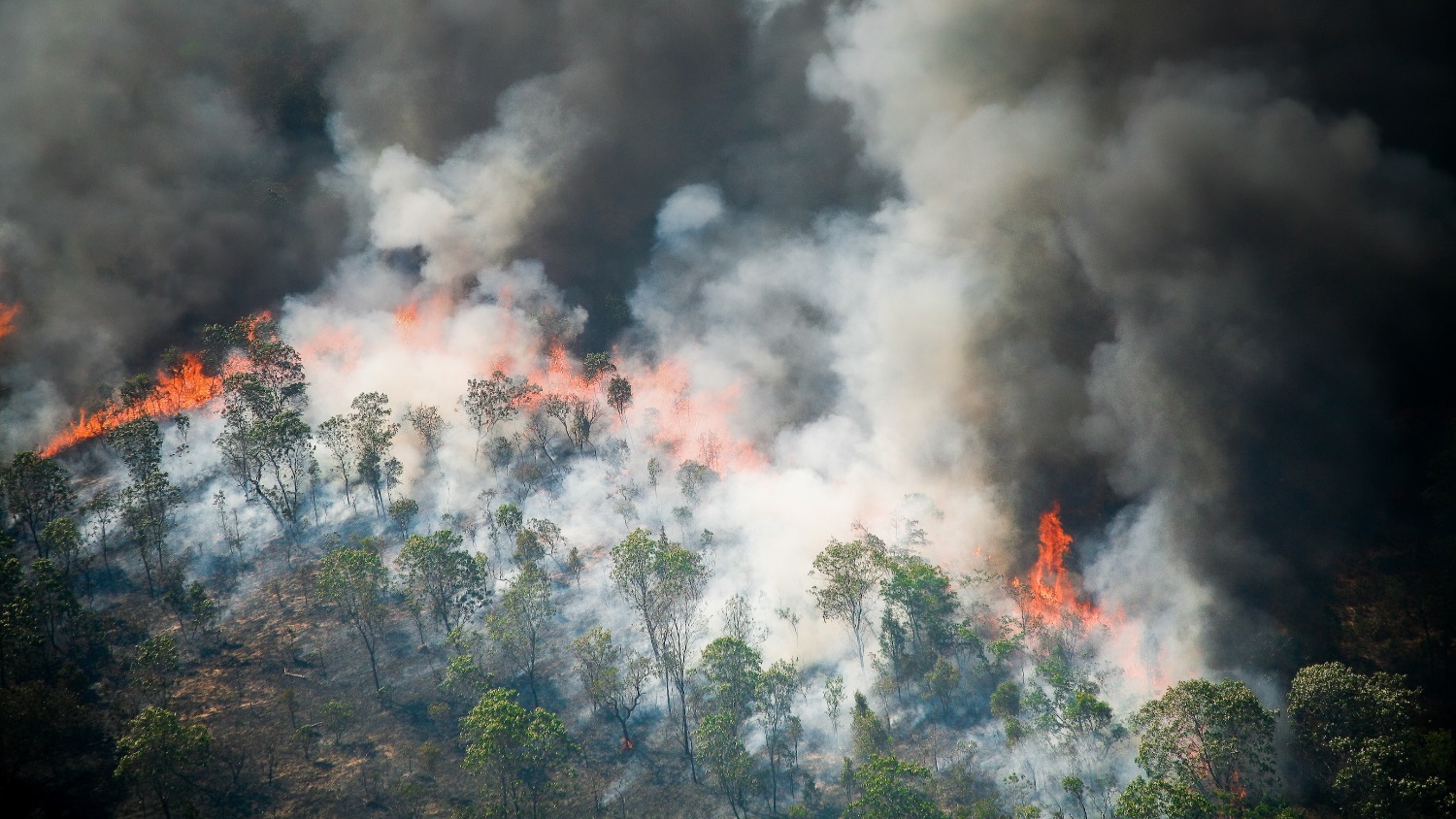5 Ways Climate Change Impacts Forests
From droughts and wildfires to pests and pathogens, climate change is wreaking havoc on the world's forests.

Forests occupy nearly a third of Earth’s land surface, providing humans and countless other species with a wide range of benefits and services — from ecological functions such as water and air purification to goods such as lumber and paper.
But according to a recent report released by the United Nations, climate change is expected to worsen over the next century as greenhouse gas emissions continue to increase, a trend that experts say will have consequences for the health of forests worldwide.
At NC State’s College of Natural Resources, Robert Scheller is examining the impacts of climate change and human activities on long-term landscape health and developing models to forecast landscape change to inform policy and management decisions.
Scheller’s most recent book, “Managing Landscapes for Change,” explores how future landscapes will be shaped by pervasive change and where, when, and how society should manage landscapes for change.
We recently spoke with Scheller, a professor in the Department of Forestry and Environmental Resources and the college’s interim associate dean of research, about the potential impacts that climate change could have on forests in North Carolina and beyond. Here’s what we found out:
Tree Migration

In response to climate change, some tree species will shift their ranges and migrate into landscapes in which they don’t typically grow.
“Climate change can create new habitats for tree species and make existing habitats unsuitable. And like any other living thing, trees go where they can survive,” Scheller said. “This process is already underway.”
Some tree species are migrating uphill and northward as temperatures increase, while other species are migrating downhill and westward as changing precipitation patterns create drier conditions.
Palmetto trees, for example, could become more common throughout North Carolina in the next 50 or 60 years as they migrate from nearby states like Georgia and Florida, according to Scheller.
“Species redistribution isn’t necessarily a bad thing. But it’s possible that some trees could go extinct, especially those with small ranges,” he said. “So if there are species we’re concerned about, we need to collect their seeds and plant them in areas where we think they’ll survive climate change.”
Forest Fires

Since 2000, an annual average of 72,600 wildfires have occurred across the U.S., scorching an average of 7 millions acres of land, including forests, each year. That’s more than double the average annual acreage burned in the 1990s. Unfortunately, though, the worst is yet to come.
Climate change is creating warmer temperatures, deeper droughts and drier vegetation, according to Scheller. These conditions will persist in the coming decades and lead to an increase in the extent, intensity and frequency of wildfires, especially in the western U.S.
According to the National Interagency Fire Center, a total of 43,438 wildfires have burned more than 4.5 million acres across the U.S. this year so far, with a majority of the blazes occurring in western states like California, Oregon and Montana. However, as the planet warms, North Carolina and other southeastern states could begin to experience larger wildfires.
“We’ve created the perfect conditions for wildfires, and I don’t see that changing anytime soon,” Scheller said. “In the South, states like North Carolina and Florida have a lot of roads that prevent fire from spreading. But under the right conditions, a large fire could certainly cross roads and cause a lot of damage.”
Scheller is currently examining the potential impact of climate change on wildfires in the Southeast, especially in the Appalachian Mountains where fighting the blazes is often difficult because of the region’s rugged terrain.
Severe Droughts
With average temperatures rising due to climate change, historically dry areas across the U.S. are likely to experience less precipitation and increased risk of longer, more intense droughts. In fact, recent droughts have been the most prevalent and severe in decades or centuries.
The latest map from the United States Drought Monitor, a collaboration between several federal agencies and the University of Nebraska, shows that at least 50% of the West is currently experiencing “severe” or “exceptional” drought conditions.
Research shows that trees respond to the stress of drought by closing their stomata, the pores that let in carbon dioxide. This forces trees to rely on stored sugars and starches, and if they run out of those energy sources before the drought is over, they can die from ‘carbon starvation’.
In addition, when trees lose too much water too quickly during a drought, air bubbles can form and prevent the transportation of water from the roots to the leaves, a process that can also result in death.
“Some landscapes are getting so dry that they can’t support forests at all. It’s pushing forests out of their physiological limits. This is especially true in the southwestern United States,” Scheller said. “But that doesn’t mean every tree is going to die. Some forests will be replaced by shrublands.”
Scheller added that the southeastern U.S., in contrast, may experience more frequent, shorter periods of precipitation due to climate change, resulting in increased forest productivity and growth.
Pests and Pathogens

When trees are exposed to a drought or wildfire, they can become less resilient to pests and pathogens, according to Scheller. And with climate change creating warmer, drier conditions in some regions across the country, forests could face increased outbreaks.
“Trees have less energy to defend themselves when they’re stressed out by drought and other challenging conditions,” Scheller said. “They become more vulnerable to insects, fungi, bacteria, viruses and so on.”
Pests and pathogens typically occur at low population or infection levels in forests, but they occasionally wreak havoc on trees. In 2018, for example, pests and pathogens damaged more than 6 million acres of forests nationwide, according to the most recent report from the U.S. Forest Service.
Climate change will likely expand the range and prevalence of forest pests and pathogens, according to Scheller. The warmer temperatures and drier conditions associated with drought, in particular, could increase the reproductive rate of certain insect species.
Scheller said this phenomenon is already evident in the western U.S. where pests populations are causing massive tree die-offs, with the bark beetle alone destroying 45 million acres of forest in recent years.
“Wildfires get all the press, but insects are killing far more trees in the western U.S. than wildfires,” Scheller concluded.
Carbon Competition

In recent years, polluting companies worldwide have announced plans to utilize forest carbon offset projects to achieve net-zero greenhouse gas emissions by 2050 as investors demand sustainable practices and governments look to promote renewable energy technologies.
These projects allow polluting companies to pay private landowners to capture, store and prevent carbon dioxide from reaching the atmosphere, according to Scheller.
Landowners who participate in these projects can earn “carbon credits” for preserving trees and then sell the credits to polluting companies so that they can continue to emit carbon dioxide, with the exchange balancing out emissions to prevent an overall increase of emissions.
But in addition to utilizing existing forests, some companies are purchasing and reforesting land in an effort to earn even more carbon credits, a strategy that could create “economic uncertainty” for the forest products industry, according to Scheller.
“A lot of companies are looking into reforestation, which is great for places like the Amazon and Africa. But it will create a lot of competition for land, and that could totally upend the forest products industry,” he said.
Scheller added that the price of paper, lumber and other forest products will likely increase in the coming decades as a result of carbon offset projects, with some landowners preferring to receive a yearly payment rather than wait several decades to log and sell their trees.
In addition, fewer trees may be available for logging due to wildfires, insects, and drought, creating further upward pressure on the price of forest products, according to Scheller.


